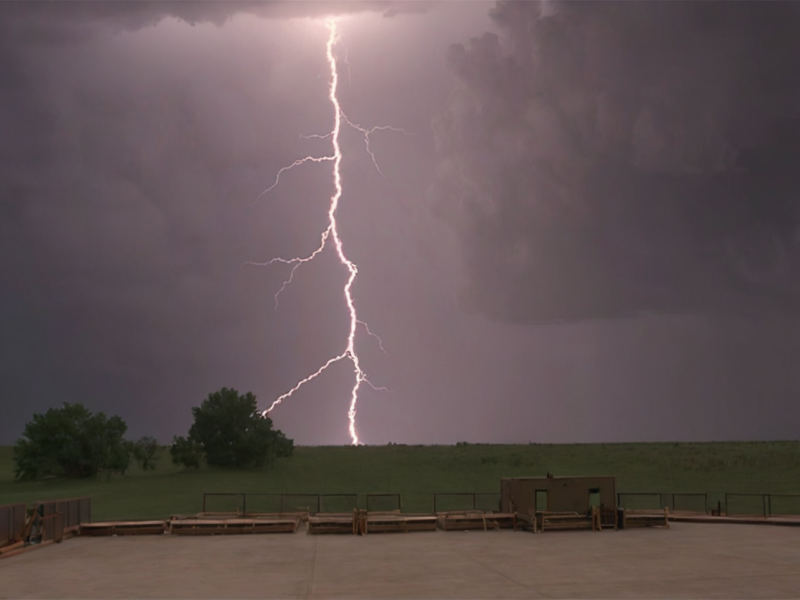Great Balls Of Fire:
Lightning And Shooting
Springtime Is Here, So Are Thunderstorms
The idea for today’s topic came yesterday while I was in the shower, lathered up and ready to shave as outside a typical line of midwestern spring thunderstorms rolled in.
Suddenly, a tremendous bolt of lightning struck nearby. Split seconds later, a peal of thunder loud enough to rattle the window caused my heart to skip a beat and the hair on my neck to stand straight out. Our first big “thunder-boomer” of the season had arrived.
It was fortunate I didn’t slit my throat with the razor in hand, but I did cut off one eyebrow and shredded part of the shower curtain into strands of vermicelli. To say I was a little bit startled is like saying Hillary Clinton is just a tiny bit bitter.
After all bodily functions returned to a reasonable facsimile of normal and I finished my shower, I considered my countless close-calls with lightning during a lifetime spent outdoors. I can’t even count the number of times I’ve been within a too-close radius of a lightning strike, but even once is so memorable as to make you hope there isn’t a second time. In my case, for some reason, the laws of probability have been stretched to the point of breaking.
Your Chances
According to the National Weather Service, an average of 27 people are killed each year by lightning in the U.S., while 243 are injured. Considering 99.99% of those folks were outdoors at the time, lighting is clearly a significant health threat to fishermen, golfers, hikers — and firearms enthusiasts.
Actually, digging into the statistics was even more startling when you realize if you live to the age of 80, your odds of being struck go down to 1/15,000 and the chance of knowing someone struck by lighting is somewhere around 1/1530. Pretty fair odds of you or someone you know getting zapped!
If you hadn’t noticed, shooting ranges are wholly populated with folks walking around with metal objects in their hands. Sometimes, those people periodically toddle over an elevated backstop or hang around under an open-air structure covered by a metal roof. All these contributing factors are a perfect way to increase your odds of experiencing what happens when thousands of amps of electricity are applied directly to the human body. As ‘tis the season, let’s talk about lightning safety and the shooter.
Staying Safe and Unfried
In my case, I’m generally fairly conservative when dealing with incoming storms but most of those memorable occasions where the thunder gods tried to obliterate Your Humble Servant were the result of that famous cliché,’ “just one more …”
You know, the proverbial — “just one more shot on the target to tighten that group up,” “one more fish,” or “one more mile to the truck.” By the time a biblical-caliber squall is imminent, it’s already too late to seek shelter.
Thus, lightning safety is primarily a matter of behavior modification.
I’ll start with the obligatory “Seek shelter early from a pending storm”-warning, which is — frankly — totally pointless advice to guys. Women will heed such suggestions but meanwhile, standing in the field is myself and every other guy, almost as if it becomes a game of “Chicken” to see who leaves last. When you realize lightning can often precede rain showers by ten miles or more, and these earliest strikes are often the proverbial “Bolt out of the blue,” it is pretty obvious the safest course of action is to head indoors before Thor starts his target practice.
I know you won’t, but don’t say GUNS Magazine and it’s matchless editor didn’t warn you!
Since we guys demonstrate an unhealthy lack a fear toward lightning, there are a few other tips to keep in mind for surviving those moments when caught flat-footed away from cover. Most of these tips have been — unfortunately — field tested by the Cinder-In-Chief of this magazine.
The first rule is to get away from any conductors of electricity, for instance the neat rifle or shotgun in your hands. Add to this list things like metal target frames, range pull carts, tall trees, small isolated structures such as storage sheds or higher ground like the target backstop. Lightning can also travel significant distances through fences or wires so stay away from those.
Notice I just described the typical firing range and its furniture.
If caught by a storm, you need to move off high ground immediately. Standing on the target berm to watch an incoming light show is certainly macho and thrilling but potentially deadly. If the range or your hunting ground is in a hollow or valley, but the walk to your vehicle is through a rise, it might make more sense to stay put until things calm down.
When walking to safety, keep group members separated by at least 20 yards to prevent additional casualties. It has been claimed that lying on the ground isn’t especially helpful if there is a nearby strike, but kneeling with only one point of ground contact on something non-conductive, such as a shooting mat, is a reasonable idea. I’ve done it when caught on an exposed ridge during a storm, but I never had a terribly close strike to test the theory.
I will say the old saw of your hair standing on end prior to a strike is true. Unfortunately, you’ll only have about 1 second of warning, and it also means you’re occupying ground zero. I experienced this odd sensation years ago at my grandparents’ cabin when lightning struck the sycamore tree right outside the screened-in porch where my family was watching one of the Apollo moon landings. We were fine — partially deafened and blinded, but otherwise fine — though the black-and-white television was DOA. By the way, does anybody know how Apollo 16 worked out?
Lots of shooting pits and firing lines have a metal roof overhead. I have no idea if this is a safe haven or not since lightning will still try to find a path to ground and habitually follows some rather odd routes. As we’re talking about thousands of amps in play, the electricity just might consider your body another good ground conduit aside from the metal roof support, with bad results. I always abandon such structures when a storm blows up in the distance.
It is said the interior of a vehicle is safe from lightning strikes due to the surrounding metal body structure isolated from the ground by rubber tires. I’ve waited out a lot of storms in vehicles, but I’ve also never seen a direct strike on someone’s car or truck, so I’m not sure if this is good advice or not. Maybe I’ll get badly surprised someday. I also wonder about the fact many vehicles nowadays are less metal and more plastic.
Helping Victims
Getting struck by lightning can cause some horrific burns, but according to medical experts, the most common and immediate cause of death in lightning accidents is stoppage of breathing. Thus, if you witness someone being struck by lightning, the first order of business is to open their airway. Sometimes, this will restart breathing on its own, but if not, artificial respiration will be needed. They also might not have a pulse, which would require CPR. The good news is getting struck by lightning isn’t necessarily fatal, especially when the victim gets immediate assistance. This is another good reason to spread out groups, so if there is a nearby strike, there will hopefully be at least one non-victim to rescue others. Finally, you can forget the old wives’ tale claiming the victim is dangerous to touch because of stored electricity. It’s simply not true.
So, to summarize today’s sermon, go inside well before the storm hits, get away from metal objects and high ground, seek substantial shelter, and be ready to give medical assistance to lightning victims. Everything should be fine. I would also add that if the situation is really, truly hairy, praying to your chosen deity is always an A1 idea. And keeping a clean pair of foundation garments in your emergency supplies is also a good idea.
Trust me, I’ve also field-tested this suggestion.
—
Want more online exclusives from GUNS Magazine delivered straight to your inbox? Sign up for our FREE weekly email newsletters.



